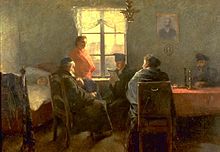Samuel Hirszenberg
Samuel Hirszenberg , Germanized Hirschenberg (born February 22, 1865 in Łódź , Russian Empire , † September 15, 1908 in Jerusalem , Ottoman Empire ) was a Polish painter .
Life
Samuel Hirszenberg in 1865, the eldest son of a Jewish weaving worker in the Polish born Lodz. Against his father's will and thanks to the financial support of a doctor, he decided to pursue a career as an artist. At the age of 15 he began his studies at the Academy of Fine Arts of Krakow , where he was strongly influenced by Jan Matejko ’s realistic painting . After two years of training in Kraków, he continued his studies from 1885 to 1889 at the Royal Art Academy in Munich . With his first larger work, Jeschibah (1887, the German title at the time, a yeshiva is depicted ), he received some attention. After an exhibition at the Münchner Kunstverein, he showed the picture at the Paris Art Exhibition in 1889 and received a silver medal for it. In Paris he completed his artistic training at the Académie Colarossi .
In 1891 Hirszenberg returned to Poland and from 1893 settled again in his native Łódź. While the pictures of the early years, such as the pictures: Talmud Study, Sabbath Afternoon, Uriel Acosta and Jüdischer Friedhof, showed a certain relationship with the Jewish genre painting by Leopold Horovitz , Isidor Kaufmann and Maurycy Gottlieb , the later ones may be more symbolic be assigned. Topics from the “tearful” Jewish history came to the fore. Mention should be made of the three best-known paintings of this period: The Eternal Jew (1899), Exile (1904) and Czarny sztandar (The Black Banner, 1905). He occupied himself with the large painting about the eternal Jews for more than four years before showing it in 1900 in the Paris Salon. Disappointed about the low response in Paris and the rejection in Munich and Berlin, he withdrew for health reasons. In 1901 he went on a trip to Italy for a year. In 1904 Hirszenberg moved to Krakow, from where he emigrated to Palestine in 1907. He became a lecturer at the Bezalel School of Applied Arts in Jerusalem. After a short and intense creative period, he died in Jerusalem in 1908.
literature
- Susan Tumarkin Goodman: The Emergence of Jewish Artists in Nineteenth-Century Europe. New York 2001. ISBN 978-1-85894-153-0 .
- Richard I. Cohen: Jewish icons: art and society in modern Europe . Berkeley 1998. ISBN 0-520-20545-6 . Pp. 223-235.
- Karl Schwarz: Jewish Artists of the 19th and 20th Centuries . New York 1949. pp. 43-49.
- Ruth: Samuel Hirszenberg: a biographical sketch. In: Ost und West , 2 (1902), issue 10. pp. 673–688. Digitized
Web links
- Herman Rosenthal, JL Lait: HIRSZENBERG, SAMUEL. In: Isidore Singer (Ed.): Jewish Encyclopedia . Funk and Wagnalls, New York 1901-1906.
Individual evidence
- ^ Cohen 1998. p. 223.
- ↑ Registration entry from 1883 Samuel Hirschenberg
- ↑ Ruth 1902. p. 685.
- ↑ Schwarz 1949. pp. 44f. Google Books
| personal data | |
|---|---|
| SURNAME | Hirszenberg, Samuel |
| ALTERNATIVE NAMES | Hirschenberg, Samuel |
| BRIEF DESCRIPTION | Polish painter |
| DATE OF BIRTH | February 22, 1865 |
| PLACE OF BIRTH | Łódź |
| DATE OF DEATH | September 15, 1908 |
| Place of death | Jerusalem |



